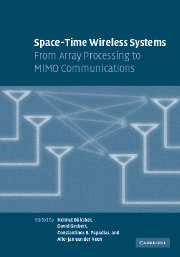Book contents
- Frontmatter
- Contents
- List of contributors
- Acknowledgments
- Introduction
- Part I Multiantenna basics
- Part II Space-time modulation and coding
- Part III Receiver algorithms and parameter estimation
- Part IV System-level issues of multiantenna systems
- 18 MIMO Gaussian multiple access channels
- 19 On information-theoretic aspects of MIMO broadcast channels
- 20 Multiuser MIMO systems
- 21 Opportunistic communication: a system view
- 22 System level performance of MIMO systems
- Part V Implementations, measurements, prototypes, and standards
- Index
20 - Multiuser MIMO systems
Published online by Cambridge University Press: 25 February 2010
- Frontmatter
- Contents
- List of contributors
- Acknowledgments
- Introduction
- Part I Multiantenna basics
- Part II Space-time modulation and coding
- Part III Receiver algorithms and parameter estimation
- Part IV System-level issues of multiantenna systems
- 18 MIMO Gaussian multiple access channels
- 19 On information-theoretic aspects of MIMO broadcast channels
- 20 Multiuser MIMO systems
- 21 Opportunistic communication: a system view
- 22 System level performance of MIMO systems
- Part V Implementations, measurements, prototypes, and standards
- Index
Summary
Receiver design for multiuser MIMO systems
Introduction
The seemingly insatiable demand for performance and capacity in cellular wireless systems has prompted the development of myriad receiver-based signal processing techniques for using system resources more efficiently. One of the most powerful coding and signal processing paradigms for this purpose is space-time processing with multiple transmit and/or receive antennas. As discussed in previous chapters, information theoretic-results show that multiple antennas can increase rate (multiplexing gain), reliability (diversity gain), or both. In this section, we propose specific coding and signal processing schemes for blind adaptive space-time processing of MIMO multiuser systems. We make use of the Alamouti space-time block code (STBC) (Alamouti, 1998; Tarokh et al., 1999) for uplink transmission, which has been adopted in a number of 3G WCDMA standards (Lucent Technologies, 1999), and blind adaptive MMSE joint multiuser detection (Reynolds and Wang, 2001; Wang and Poor, 2004; Verdú, 1998; Honig et al., 1995), and space-time decoding for base station reception. Related work includes the results by Hochwald et al. (2001), Papadias and Huang (2001).
Some of the results in this section have been published previously in Reynolds et al. (2002b).
Blind space-time multiuser MIMO reception
We consider a K-user code division multiple access (CDMA) wireless cellular system with processing gain N operating in flat block fading with MB base station antennas and MU antennas at each mobile unit. For simplicity of exposition, we will consider only MU = MB = 2 and BPSK modulation in this section.
- Type
- Chapter
- Information
- Space-Time Wireless SystemsFrom Array Processing to MIMO Communications, pp. 406 - 425Publisher: Cambridge University PressPrint publication year: 2006



